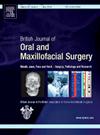Quality of life after treatment of dentofacial deformity: a cross-sectional study of 311 patients at various stages of surgical treatment
IF 1.9
4区 医学
Q3 DENTISTRY, ORAL SURGERY & MEDICINE
British Journal of Oral & Maxillofacial Surgery
Pub Date : 2025-05-01
DOI:10.1016/j.bjoms.2025.02.007
引用次数: 0
Abstract
The aim of the study was to investigate self-reported quality of life (QoL) following orthognathic surgery for patients with dentofacial deformities (DFD) correlated to the type of osteotomy performed. Self-reported QoL of 311 patients was evaluated, before preoperative orthodontic treatment (n = 91), before surgical treatment (n = 76), two years (n = 35), five years (n = 56) and eight years after treatment (n = 53), using the validated condition specific Orthognathic Quality of Life Questionnaire (OQLQ). Also, previous experience with orthodontic treatment was evaluated for all patients. Patients who underwent single-jaw mandibular setback surgery and Le Fort I osteotomies had the most pronounced change in global OQLQ scores. Oral function was significantly improved in both groups, and dentofacial aesthetics and awareness of dentofacial deformity was significantly improved in the mandibular setback group. The effect did not significantly change over time for any of the groups. The extent of orthodontic treatment in the preoperative stage did not significantly alter QoL scores. Orthognathic surgery improved self-reported quality of life in a Norwegian population. The type of dentofacial deformity and surgical procedure differed in some aspects, but the global OQLQ scores remained consistent.
牙面畸形治疗后的生活质量:311例手术治疗不同阶段患者的横断面研究。
本研究的目的是调查与截骨类型相关的牙面畸形(DFD)患者在正颌手术后自我报告的生活质量(QoL)。采用经验证的条件特异性Orthognathic Quality of Life Questionnaire (OQLQ),对311例患者在正畸治疗前(n = 91)、手术前(n = 76)、治疗后2年(n = 35)、5年(n = 56)和8年(n = 53)自我报告的生活质量进行评估。此外,对所有患者先前的正畸治疗经验进行了评估。接受单颌下颌挫折手术和Le Fort I截骨术的患者在总体OQLQ评分上的变化最为明显。两组患者的口腔功能均有明显改善,下颌退缩组牙面美观度和牙面畸形意识均有明显改善。任何一组的效果都没有随着时间的推移而发生显著变化。术前正畸治疗的程度对生活质量评分无显著影响。正颌手术改善了挪威人自我报告的生活质量。牙面畸形类型和手术方式在某些方面存在差异,但总体OQLQ评分保持一致。
本文章由计算机程序翻译,如有差异,请以英文原文为准。
求助全文
约1分钟内获得全文
求助全文
来源期刊
CiteScore
3.60
自引率
16.70%
发文量
256
审稿时长
6 months
期刊介绍:
Journal of the British Association of Oral and Maxillofacial Surgeons:
• Leading articles on all aspects of surgery in the oro-facial and head and neck region
• One of the largest circulations of any international journal in this field
• Dedicated to enhancing surgical expertise.

 求助内容:
求助内容: 应助结果提醒方式:
应助结果提醒方式:


